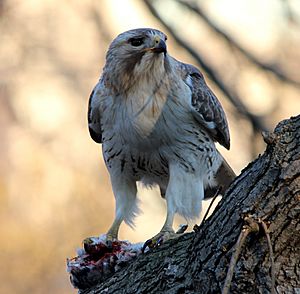Pale Male facts for kids

Pale Male eating a pigeon
|
|
| Species | Buteo jamaicensis |
|---|---|
| Sex | Male |
| Hatched | 1990 |
| Died | May 16, 2023 (aged 32–33) Long Island, New York, U.S. |
| Nation from | United States |
| Known for | Nesting on 927 Fifth Avenue |
| Mate(s) |
|
Pale Male (born 1990 – died May 16, 2023) was a famous red-tailed hawk. He lived in and around New York City's Central Park for many years. A birdwatcher named Marie Winn gave him his name. She called him Pale Male because his head feathers were unusually light in color.
Pale Male was special because he was one of the first red-tailed hawks known to build his nest on a building. Most hawks build their nests in trees. He became known for starting a family of hawks that also lived in the city. Each spring, people would gather with telescopes near Central Park's Model Boat Pond. They watched his nest and his baby hawks at 927 Fifth Avenue.
Contents
Pale Male's Life
Early Years and First Mates
Pale Male arrived in Central Park in 1991. He was a young hawk then. He tried to build a nest in a tree, but some crows chased him away. Later, he found a place to rest on a building on Fifth Avenue. This building was right across from the park.
Around 1992, he found his first partner, named "First Love." She got hurt later that year. While she was away, Pale Male found another mate, named Chocolate. After a few tries, Pale Male and Chocolate had three baby hawks in 1995. These young hawks grew up and stayed in Central Park. Chocolate sadly died later that year after an accident with a car.
First Love returned to Central Park after she got better. She and Pale Male reunited and raised more baby hawks together. Birdwatchers loved watching the chicks grow. They would wait to see them take their first flights. Pale Male was a good dad, bringing food to his babies about five times a day. In 1997, First Love died after eating something harmful in Central Park.
New Partners and City Nests
From 1998 to 2001, Pale Male's mate was a hawk called Blue. They had about 11 baby hawks during those years. Blue disappeared around the time of the September 11 attacks in 2001.
In early 2002, Pale Male was seen with a new mate, Lola. They raised seven baby hawks between 2002 and 2004. They built their nest on a fancy stone decoration above a window. This was on a building at 927 Fifth Avenue in Manhattan. Lola disappeared in December 2010 and was thought to have died.
A new mate, Lima, appeared in early 2011. She was also called "Ginger" because of her dark neck feathers. Lima was a young hawk. She and Pale Male had two baby hawks in 2011. These were the first baby hawks in that nest since 2004. Lima died in early 2012, likely after eating a poisoned rat.
After Lima's death, Pale Male found a new mate named Zena. They had three young hawks. Two of them got sick, but they were rescued and released back into Central Park. In September 2012, Zena disappeared. Pale Male then took a new mate, named Octavia. She was his eighth known partner.
Many people believed Pale Male was still alive in 2021. If so, he would have been 31 years old. This would make him one of the oldest red-tailed hawks ever known!
Pale Male's Death
On May 16, 2023, Pale Male was found sick in Central Park. An urban park ranger found him. A wildlife helper named Bob Horvath took him to a vet right away. They did tests to find out what was wrong. Sadly, Pale Male died that evening. He was 33 years old.
Other Red-Tailed Hawks in New York City
Since the year 2000, other red-tailed hawk pairs have nested in or near Central Park. Some have been successful in raising their young.
For example, a hawk couple named Junior and Charlotte nested on a hotel in 2005. They successfully raised two baby hawks. Other hawk pairs have tried to nest on buildings near Central Park. Some have been successful, like a pair that nested in the park's Pinetum in 2022.
Many red-tailed hawks now live all over New York City. A study in 2007 found that hawks were breeding in 32 different places in the city. Since 2010, there have usually been about ten active red-tailed hawk nests in Manhattan each year. Even small green spaces in the city might have hawk visitors. Larger parks, like Washington Square Park, can even support nesting hawk families.
Images for kids


